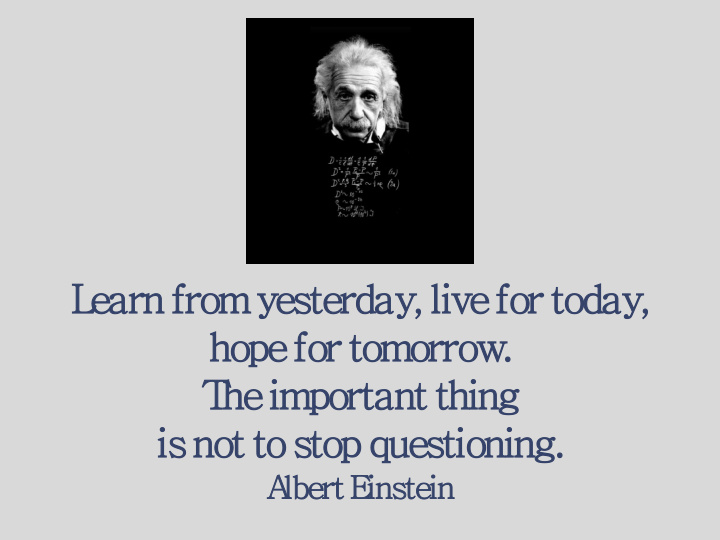



L earn from yesterday, live for today, hope for tomorrow. T he important thing is not to stop questioning. A lbert E instein
Getting ing to the Core Superi rior or standard rds Supporti portive e scho hool ol clim imate te Succe cess ssful ful students nts BIG IDEAS AND ESSENTIAL QUESTIONS CERTIFICATED LEARNING AND ACHIEVEMENT SPECIALISTS ROSEMARY BALL CORY GONZALEZ ERIC GREEN KAREN KNECHT MARTA MOYER KAREN STEPANSKI MONICA CURIEL STAFF DEVELOPMENT DEPARTMENT JUDITH BARDEN, DIRECTOR SEPTEMBER 13, 2012
Learning Goals… 1. Why are big ideas and essential questions crucial for student learning? 2. What is the criteria for “big ideas” and “essential questions”?
Common Core Unit
Looking at the Big Picture How do you create a unit of study with deeper meaning and better understanding of the content?
The Process of Unit Design Establish the Establish Relevant Goal: essential questions Create (content standards, “ BIG IDEAS ” that will lead students course or program to the objectives , learning “big idea ” outcomes) Create lessons “Bundle” Assess that will allow CC standards student students to answer needed to teach the essential learning the lessons questions Understanding by Design by Wiggins and McTighe
What makes it different from a theme-based unit? Let’s look at a typical theme-based unit without a big idea or essential questions to guide instruction and student learning.
Leading with Big Idea and Essential Questions
An idea is “big” if it helps us make sense of lots of confusing experiences and seemingly isolated facts. It’s like the picture that connects the dots or a simple rule of thumb in a complex field. Grant Wiggins
The Big Idea … • emphasizes the common characteristics of a unifying concept • is a concise statement, principle, or generalization • promotes in-depth understanding • applies across disciplines 12
Questions to Help Determine the “Big Idea”
Practice Examples - Non Examples Big Ideas Example Non Example
Answers Big Ideas Non Example Example
Using Current Resources Open Court Themes – 2 nd Grade Exploring the Theme: Look Again The big idea of each story is connected to the theme.
Using Current Text… Big Idea: An animal has a relationship with the ecosystem of which it is a part.
Using Current Resources • Holt 6 th Course-12 th grade • Exploring the Unit: The Romantic Period • Big Idea: Shifts in society result in cultural change.
Look Below The Surface…. to uncover the Big Ideas.
Essential Questions
Essential questions . . . • have no right or wrong answers • promote inquiry • focus student learning toward the big idea • foster critical thinking and deeper meaning • spark curiosity and a sense of wonder • Engage students in real life problem-solving
Essential Questions Checklist
Essential Questions Examples Non Examples • • What traits and characteristics How many legs does a spider determine a classification? have? • • Where do artists get their Did nature influence Monet? ideas? • What determines “value”? • How many dimes in a dollar? • What distinguishes a fluent • What is the meaning of the foreigner from a native Greek term technology from speaker? its Greek root “ techne ”? • How does habitat influence • Why were settlements how we live? developed around lakes and rivers?
Essential Questions Tips • Organize unit around EQs • Post 1-2 per lesson/3-5 per unit • Link to lesson activities • Sequence questions to assure a natural flow of thought. • Use student-friendly language
CREATING ESSENTIAL QUESTIONS USING OUR CORE PROGRAM
Using Current Text 2 nd Grade OCR Story: “I See Animals Hiding” Inquiry Connections: (at the beginning of each story in the TE! ) 2 nd Grade OCR Story: “I See Animals Hiding” Focus Question : at the top of each story.
Using Current Text Holt 6 th Course-12 th grade Preview: Think About… Turn these into Essential Questions !
Using Current Text
Concept Big Idea EQ Current Texts Aligned with Common Core Unit First Grade Concept Big Idea Essential Question Unit 3 People in a What are some community depend things you and your Our on each other for family need, and Neighborhood the things they where do you go to at Work need. get them?
Concept Big Idea EQs Current Texts Aligned with the Common Core Fourth Grade Concept Big Idea Essential Questions Unit 2 Success in business What does it take to depends on being start a business? Dollars and able to meet Sense people’s needs. What makes a business successful?
Concept Big Idea EQ Current Texts Aligned with the Common Core Secondary Level Concept Big Idea Essential Question Revolution Conflict leads to Does the Bill of change. Rights serve all citizens?
Back to the BIG PICTURE!
The CCSS Shift Grade Literary Informational 4 50% 50% 8 45% 55% 12 30% 70%
Moving forward, teachers will use core programs to shift toward CCSS: • Choose the best selections from the unit that help students understand the big idea. • Remove some selections while maintaining the foundational skills. • Replace these selections with expository/informational texts that help us understand the big idea.
Teaching Strategies • Students will use “close read” strategies to comprehend varied complex texts • Students will cite evidence to answer text dependent questions • Teachers will embed the teaching of academic vocabulary within the text • Students will express their understanding through oral presentations or writing
Common Core Unit Next Steps…
Finally . . . The words know and understand are not synonyms. A student can have an accurate and thorough knowledge of something without understanding why the knowledge is justified, what the knowledge means, or what can be done with that knowledge. Wiggins and McTighe, 1999,UbD Handbook
Recommend
More recommend